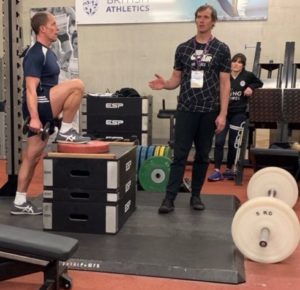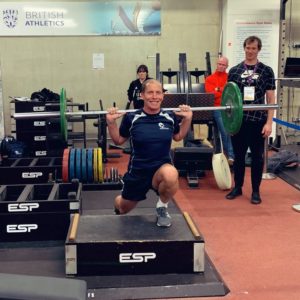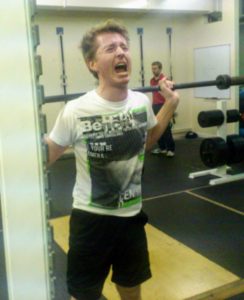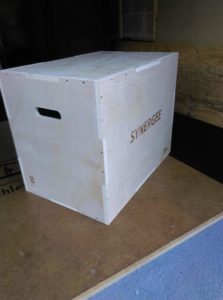Main Menu
Latest Blog Entry
User login
IFAC Reflections Part 3
Finding the failure point in athletes
My final thoughts on IFAC, reviewing Jerome Simian’s leg strengthening exercises and progressions.
“If the structure is weak, it won’t allow the nervous system to show what it can do.”
Regular readers and our athletes will know about Structural Integrity, Simian uses a different phrase, but the meaning is similar.
Leg Strengthening Progressions

I was chosen as the subject for the next workshop, Simian having observed my hurdling efforts earlier in the day.
He took me through a series of exercise progressions that were designed to find my failing point. That then would give him more of an idea about how to design a suitable training programme for me.
I have some idea about strength training, but still managed to take a lot from this session.
The progressions were as follows:
- Step up with toes up. An oldie which I have used since 1995 (Tippett & Voight), but taken to a new height by Simian. The foot on the ground has its toes up, forcing the foot on the step to do all the work.
- The key here is then to lock the hip at the top of the step which requires more control. You can see the two young athletes below working on it in our gym.
- The progressions around this are to do a decline step- which emphasises quad work more, or to use a higher step– which emphasises hip flexors more.
- Once the height can be achieved, load can be added with dumbbells, then barbell either in front or back.
The knee on the step needs to be pushed forward so that the hip extends first, then the knee (hip-knee-ankle in that order). The exercise must reflect what happens in the sport.
These high box step ups are a great use of the box that coincidentally our club had just received before Christmas.
Split squat or lunge?
The next exercise was the split squat, the difference between that and a lunge is that the shin remains vertical in a lunge but has a positive forward angle in the split squat.
Here was another exercise that a visual demonstration would have helped me with- instead, after several misfirings from me, and less then useful input from the coaching bystanders, I got the hang of it.
Pushing the knee forward is important to lower the body so that the rear knee touches the ground, then coming out the hips must move up first and then back. This ensures that the same pattern of hips-knees-ankle extension occurs. It is tempting to push back.
I explained that due to my background- pushing in and out in a low stance without raising my hips was part of my karate sparring drills.

The progression from here was with the front foot elevated, a low stable step is enough.
This creates a lot more hip flexion and extension and is good for those athletes who are yet unable to do a full squat.
I then had the pleasure of receiving more weight (remember, the aim was to find my failure point).
When the barbell is in front a lot more hip and buttock is used compared to when the barbell is on the back of your shoulders.
Front squats and back squats
We have covered the difference between back squats and front squats previously, but I still gained a few worthwhile cues and technical points. It is always worth getting coached by someone new to get a fresh perspective, especially if, like me, you are training on your own all the time.

- Simian wanted me to feel like I was “strangling yourself” and to rack the bar higher in the Front Squat. He also told me to push my knees out wider and over my toes more.
- On the way down I was to flex my ankles, then knees and then my hips (the same as landing mechanics) and on the way up to do the reverse (same as acceleration).
- He thought my front squat was ok, but noticed that my back squat had a shift to the left when I lowered down. He wanted me to squat with very wide hands and wider than normal legs for me.
Coaching the person in front of you
So far so good, a coach has seen some good points, but then found a weakness or error and now attempts to correct it. The back squat with load was my “failure point“.
Simian had two solutions to help me:
- Practise Cossack squats (a lateral lunge with one foot facing sideways) to help my tight left adductors and my tight right hip flexors. This, he surmised, was the reason for my poor squatting technique. No problem.
- He stood and held my right hand and rubbed the bones around a bit. Then he watched me move again.
Some people may enjoy having a Frenchman hold their hand and look dreamily into their eyes, I am not one of those people. I noticed no change in my movement.

Some helpful members of the audience then started throwing in their suggestions like “It’s because his femurs have funny shaped heads”. I was way out of my depth here; surrounded by coaches with X-Ray vision.
This was where I started to become sceptical and moderately frustrated (I had yet to have a cup of tea that afternoon).
I have injured my right knee previously whilst sprinting. It has been aggravated by landing incorrectly from a somersault. I think I favour that side when back squatting.
Repeatedly leaning to that side may well cause a learned effect and my left adductors and right hip flexors to be tight as a result of my bad technique, rather than the cause.
If what Simian had said or done had made an improvement, I would be a convert. It might well work in his environment with more time: I have empathy for trying to present to a group of coaches with a subject I have just met.
I much prefer creating movement problems for the athlete to solve, like the Cossack squats, than trying to find the magic pressure point to release.
What I can say for certain is that in the context of this environment, despite having some competency in the gym, I was confused. This could be because Simian kept referring to me in the third person and was addressing the coaches, rather than coaching me.
The good news was that it reminded me not to do this with the athletes I coach. If I do make a coaching point to the whole group using a subject, I then need to ensure that I actually coach the subject too!
Depth jumps
The final part of the workshop was a bit less structured and became more of a loose discussion. It was based around depth jumps.
Once again I was chosen to be a subject, and to perform an exercise I rarely practise.

I am used to landing following vaults and jumps in Parkour, but often with a roll afterwards. I am unused to landing from height with a stiff foot and ankle. Once again I think being a subject was less useful in the context of trying to learn.
I simply couldn’t get the point of the exercise: Simian didn’t demonstrate, so there were a lot of verbal cues flying around, with heckling from the side lines.
If I was supposed to land with pretension, I think the box was too high to start. I would always get the athletes to practise off a small step at first and then get higher. Simian was trying to find “failure points”, but the learning effect would be interfering in his assessments.
I tried with shoes on and then off, and then had my ankles and feet rubbed and moved around a bit. No improvement in what I was doing occurred, but I kept saying “I don’t know what I am supposed to be trying!”
My failure point was being uncertain of the point and intent of the task we were trying to do.
A few interesting points did come out:
- Ankle mobility in throwers is important because it allows the torso to remain more upright during the rotation. Lack of mobility means that the knees or hips have to flex to get lower which means the torso is more likely to bend too.
- Two of the “athlete basics” are a good hip extension without pelvic tilt, and being able to fully extend and flex the ankle.
- The toe test exercise to see how your ankle and feet work when flexed compared to extended. Try this at home: keep the main part of your foot on the floor and raise your toes off, then curl them underneath. Then try the same with your ankles flexed.
You will probably find that your feet need to work a bit harder. Remember that they are the first point of contact when running, so neglect them at your peril.
Summary
Simian succeeded in showing his methodology. He found the “limiting factor” in myself and LC and then showed some ideas on how to develop our weak points.
This was enlightening.
He looks for the biggest limiting factor because that will give you the most gains if you can improve it. This makes sense.
Some demonstrations would have been useful, as well as remembering to coach the athlete, rather than just present to the audience. When attending a seminar I always look at how the coach coaches rather than just what they coach.
Simian was very good at explaining WHY in his approach, but less so in some of the exercises.
I took extensive notes, even though I attended only one of the four strands in the middle of day three. I have missed more than I have recorded, so other coaches may like to leave their feedback below.
I have already applied some of the lessons learnt, trialled it myself, and I will be meeting with Rhys Llewellyn-Eaton in 2 weeks’ to share ideas as he was also there.
I would recommend IFAC to other coaches who wish to learn about improving the athleticism of their players. The staff and presenters were friendly, approachable and were all there to help educate the attendees.
Client Testimonials
 Middlesex LTA
Middlesex LTA
James has been training the top performance players in the county and has proved a great success. The sessions are well organised and the feedback and the programmes given to the players are excellent.
More

